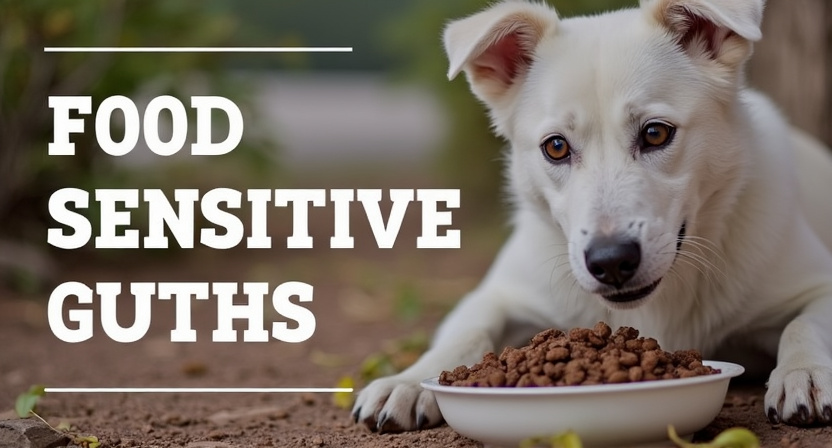Freeze-dried dog food is an excellent option for pups with touchy tummies. It’s processed less than traditional kibble and keeps more of its nutritional value. The flash-freezing and vacuum-drying method locks in the natural tastes and nutrients of raw ingredients. This creates a food that’s easy to store, simple to digest, and tasty for dogs with stomach issues.
Table of Contents
ToggleKey Takeaways:
- Freeze-dried dog food packs more nutrients than regular kibble
- Dogs with sensitive stomachs do best with limited ingredient and single-protein recipes
- Some brands include probiotics and digestive enzymes to boost gut health
- Switching to freeze-dried food should be done slowly for dogs with sensitive digestion
- Store freeze-dried food in a cool, dry place to keep it fresh and extend its shelf life
What is Freeze-Dried Dog Food and Why It’s Great for Sensitive Stomachs
Freeze-dried dog food is a revolutionary option for pups with sensitive stomachs. It’s made by flash-freezing raw ingredients and removing moisture through a vacuum process, resulting in a shelf-stable product with less than 5% moisture content. This unique preparation method offers several benefits:
Key Advantages for Sensitive Stomachs
- Nutrient Retention: The freeze-drying process preserves the original nutrients, vitamins, and minerals found in raw ingredients.
- Enhanced Digestibility: Minimal processing makes the food highly digestible, perfect for dogs with sensitive guts.
- Natural Flavor: The method maintains the food’s natural taste, encouraging even picky eaters to enjoy their meals.
- Shelf-Stable: No need for refrigeration, making it convenient for storage and travel.
I’ve found that freeze-dried dog food is an excellent choice for pups with digestive issues. Its high nutrient retention and digestibility can help alleviate stomach sensitivities while providing a tasty meal. The minimally processed nature of freeze-dried food means it’s closer to a dog’s natural diet, potentially reducing the risk of allergic reactions or digestive upsets. If you’re looking to switch your sensitive pup to a new diet, freeze-dried options are worth considering for their nutritional benefits and palatability.
Choosing the Right Freeze-Dried Dog Food for Sensitive Guts
Key Ingredients for Digestive Health
When selecting freeze-dried dog food for sensitive guts, I recommend focusing on limited ingredients and single-protein sources. This approach can help pinpoint and avoid potential allergens. Steer clear of common triggers like grains, dairy, and soy. For dogs with severe sensitivities, novel proteins such as rabbit or venison can be excellent alternatives.
Boosting Digestive Support
Don’t overlook the importance of probiotics and digestive enzymes in promoting gut health. These beneficial components can significantly improve your dog’s digestion. Additionally, proper hydration is crucial. I suggest rehydrating freeze-dried food with water, bone broth, or goat milk to enhance digestibility and ensure your pup stays well-hydrated.
Top Recommended Brands for Sensitive Stomachs
Leading Freeze-Dried Options for Delicate Digestion
I’ve identified several top-notch freeze-dried dog food brands that cater to pups with sensitive stomachs. Vital Essentials stands out with its single-protein recipes, offering a crunchy texture that’s fortified with fiber and fish oil. For dogs needing extra digestive support, Primal includes probiotics in their varied recipe lineup.
Stella & Chewy’s offers high-protein, grain-free options packed with organic fruits and vegetables, ideal for dogs with grain sensitivities. If ingredient transparency is a priority, Open Farm provides 100% traceable ingredients and boasts animal welfare certifications.
Dr. Marty Nature’s Blend caters to various life stages and sensitivities, focusing on animal-source proteins. Here’s a quick rundown of key features:
- Vital Essentials: Single-protein, fiber-rich
- Primal: Probiotic-enhanced, diverse recipes
- Stella & Chewy’s: High-protein, grain-free
- Open Farm: Traceable ingredients, ethically sourced
- Dr. Marty Nature’s Blend: Life stage-specific, animal proteins
These brands offer excellent options for dogs with sensitive guts, combining quality ingredients with digestive-friendly formulations. Always consult your vet before switching your dog’s diet, especially if they have specific health concerns.
Transitioning Your Dog to Freeze-Dried Food
Gradual Transition Process
Switching your dog to freeze-dried food requires a careful approach, especially for pups with sensitive stomachs. I recommend starting with a small amount mixed into their current diet. Gradually increase the proportion of freeze-dried food over time, allowing your dog’s digestive system to adjust smoothly. This method minimizes potential upset and helps your furry friend adapt to the new food comfortably.
Enhanced Palatability and Texture
Freeze-dried dog food often boasts intense flavors and aromas that dogs find irresistible. When rehydrated, it has a softer texture compared to traditional kibble, making it gentler on sensitive stomachs. This combination of appealing taste and easier-to-digest consistency can make the transition more enticing for your pet. The improved palatability might even encourage picky eaters to embrace their new diet more readily. Remember, patience is key during this process. By taking it slow and observing your dog’s reactions, you’ll set the stage for a successful dietary change that supports their digestive health.
Storage and Shelf Life of Freeze-Dried Dog Food
Proper Storage Techniques
Freeze-dried dog food boasts excellent shelf stability, making it a convenient option for pet owners. I recommend storing it at room temperature in a cool, dry place. This type of food doesn’t need refrigeration, simplifying storage and travel. To maintain freshness, it’s crucial to seal the package tightly after each use. Here are key points to remember:
- Keep in a cool, dry area
- Avoid exposure to moisture or heat
- Seal package tightly after opening
- Check expiration dates regularly
By following these storage guidelines, you’ll ensure your dog’s freeze-dried food stays fresh and nutritious for longer periods. This extended shelf life is particularly beneficial for dogs with sensitive stomachs, as it reduces the risk of spoilage and maintains the food’s quality.
Monitoring Your Dog’s Progress
Observing Digestive Improvements
Keep a close eye on your dog’s digestion after switching to freeze-dried food. Look for signs of improved stool consistency, reduced gas, and increased energy levels. These indicators suggest the new diet is working well for your pup’s sensitive gut.
When to Seek Professional Help
If digestive issues persist after a few weeks on the new diet, it’s time to consult your vet. They might recommend further tests or dietary adjustments. Don’t hesitate to discuss potential food allergies or intolerances, as these can be underlying causes of ongoing digestive problems. Your vet can help pinpoint specific ingredients that might be triggering sensitivities and guide you towards the best freeze-dried options for your dog’s unique needs.
Sources:
The Hungry Puppy: Best Freeze-Dried Dog Food for Dogs with Sensitive Stomachs
The Spruce Pets: Best Freeze-Dried Dog Foods
Dog Food Advisor: Best Freeze-Dried Dog Foods
Open Farm: Best Dog Food for Sensitive Stomach
Frequently Asked Questions
What is freeze-dried dog food?
Freeze-dried dog food is made by flash-freezing raw ingredients and removing moisture through a vacuum process, resulting in a shelf-stable product with less than 5% moisture content.
Why is freeze-dried dog food good for sensitive stomachs?
It’s highly digestible, retains nutrients, and is minimally processed, making it easier on sensitive digestive systems and reducing the risk of allergic reactions.
How do I choose the right freeze-dried dog food for sensitive stomachs?
Look for limited ingredients, single-protein sources, and avoid common triggers like grains, dairy, and soy. Consider options with probiotics and digestive enzymes.
What are some recommended brands for dogs with sensitive stomachs?
Top brands include Vital Essentials, Primal, Stella & Chewy’s, Open Farm, and Dr. Marty Nature’s Blend.
How do I transition my dog to freeze-dried food?
Start with a small amount mixed into their current diet and gradually increase the proportion over time to allow your dog’s digestive system to adjust smoothly.
How should I store freeze-dried dog food?
Store it at room temperature in a cool, dry place. Keep the package tightly sealed after opening and check expiration dates regularly.
How can I monitor my dog’s progress on freeze-dried food?
Look for signs of improved stool consistency, reduced gas, and increased energy levels. If issues persist after a few weeks, consult your vet.
Do I need to rehydrate freeze-dried dog food?
Yes, it’s recommended to rehydrate freeze-dried food with water, bone broth, or goat milk to enhance digestibility and ensure proper hydration.














